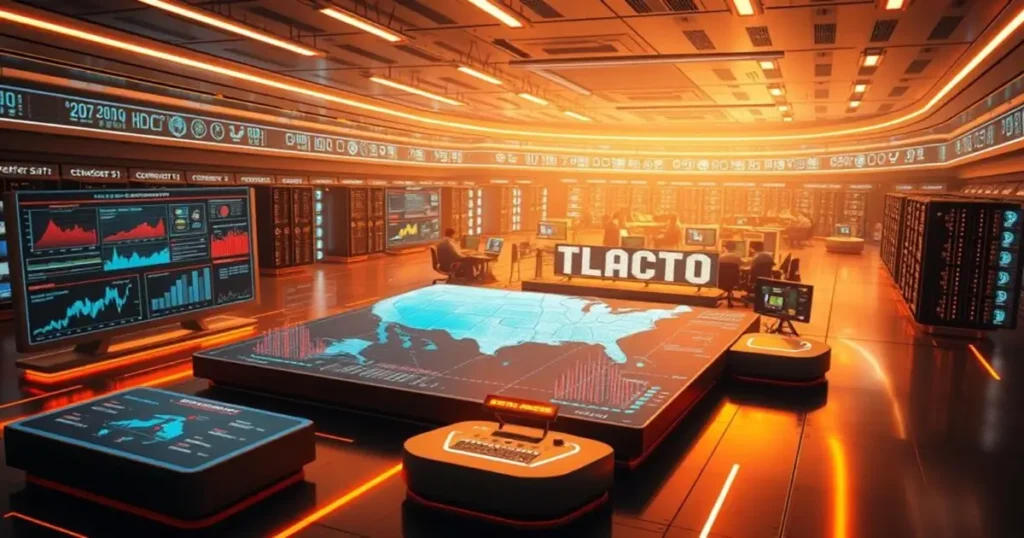Artificial intelligence is changing how we predict election results. It gives us deep insights into voter behavior and campaign strategies. This is a big shift in political technology.
Now, election forecasting uses AI instead of old polling methods. AI looks at lots of data like demographics, social media, and past votes. This makes predictions more accurate and detailed.
The 2024 election shows how important AI is in politics. About 60 countries will vote, and AI is key to understanding their elections and voters’ feelings.
Table of Contents
Understanding the Evolution of Election Predictions Through AI Technology
The world of election predictions has changed a lot with AI. Machine learning algorithms are now key in understanding voters and predicting election results.
Old polling methods are being left behind by AI. By 2024, over 60 elections worldwide will use AI, marking a big change in data collection and analysis.
The Limitations of Traditional Polling
Traditional polling faces big challenges. These include:
- Limited sample sizes
- Potential respondent bias
- Inability to capture real-time sentiment changes
- Difficulty in predicting complex voter behavior
Machine Learning’s Electoral Revolution
Machine learning has changed how we analyze elections. It can:
- Analyze social media trends
- Predict voter sentiment
- Identify demographic voting patterns
- Generate more accurate forecasts
Key Components of AI Election Prediction Systems
AI systems use many data sources and advanced algorithms. The goal is not just to predict outcomes, but to understand the nuanced dynamics of voter behavior.
AI technologies are transforming electoral processes, giving us new insights into voter preferences and election results.
AI is making election forecasting better, more data-driven, and adaptable to fast-changing political scenes.
How Can AI Be Used to Predict Election Results
AI is changing how we predict election results. It uses advanced voter behavior modeling. Our research shows new ways to make polling more accurate and dynamic.
AI can analyze many data sources to understand voter choices. It uses strategies like:
- Real-time social media sentiment analysis
- Demographic data integration
- Historical voting pattern recognition
- Personalized voter profile generation
A study at Brigham Young University showed AI’s power. Researchers used AI to predict voter behavior with great success. The AI personas matched human voting patterns across multiple presidential elections, showing AI’s strength.
New AI tools help make detailed voter simulations. These tools can focus on different groups, making analysis more precise. This helps predict election results better.
AI can do more than just predict. It helps campaigns understand voters better. This leads to more effective messages and strategies. With 60 countries voting in 2023, AI’s role in politics is expanding.
AI is not replacing human insight but augmenting our understanding of electoral dynamics.
Advanced Sentiment Analysis and Social Media Mining
The digital world has changed how we see voter views. Sentiment analysis and social media mining are key tools for understanding public opinion during elections.
Our study shows how AI uses natural language processing to find voter feelings on social media.
Natural Language Processing for Voter Sentiment
Natural language processing lets AI understand complex emotions in online talks. By looking at tweets and social media, we find small changes in what people think.
- AI can check about 79,760 tweets very well.
- Machine learning can guess feelings with up to 95% accuracy.
- Algorithms show different skills in guessing:
- Random Forest: 89% accuracy
- Decision Tree: 86% accuracy
- Support Vector Machine: 80% accuracy
Real-time Analysis of Social Media Trends
Social media mining gives quick views on voter actions. Real-time trend analysis lets campaigns see how feelings change.
Demographic Data Integration
AI mixes sentiment analysis with demographic data for better models. This helps political teams understand what voters want deeply.
The future of election prediction is in smart use of social media insights and advanced AI.
AI-Powered Voter Behavior Modeling
Artificial intelligence has changed how we understand voters. AI can handle huge amounts of data with great accuracy. This helps political campaigns know what voters want better than ever before.
Our research shows AI’s key strengths in voter modeling:
- Real-time sentiment analysis across social media platforms
- Comprehensive demographic profiling
- Predictive modeling of voting tendencies
- Identification of possible swing voters
AI’s power comes from combining many data points. It looks at psychographics, preferences, behaviors, and media consumption. This way, AI creates detailed models of voting patterns. These models help campaigns get to know voters’ deep reasons for voting.
AI uses advanced techniques like deep learning for better predictions. The Electronic Registration Information Center (ERIC) is a great example. It uses machine learning to analyze voter data and offer smart advice.
Campaigns can now make voter groups in real-time. They can target specific voters with great accuracy. This method helps campaigns use their resources better and send messages that really speak to voters.
AI is changing how we analyze elections, giving us insights we couldn’t get before.
As we get closer to the 2024 elections, AI will be more important than ever. It will help us understand and guess how people will vote.
Machine Learning Algorithms in Electoral Forecasting
Political predictions have changed with advanced machine learning algorithms. These new tools are making election forecasting better. Our research shows how AI is changing how we predict election results.
Machine learning algorithms give us deep insights into voter behavior and trends. They analyze huge datasets to find patterns that old methods miss.
Predictive Analytics and Pattern Recognition
Our study on election data shows the strength of predictive analytics. It helps us understand voters better. Key methods include:
- Sentiment analysis on social media
- Tracking voting trends in real-time
- Combining data from many sources
Data-Driven Decision Making
Election forecasting models use advanced machine learning to turn data into useful insights. Dynamic prediction models keep learning and improving. This makes their predictions very accurate.
Statistical Modeling and Validation
It’s important to validate election forecasting models. Our research proves AI models can be very accurate. For example, GPT-3 language models matched voting patterns in U.S. presidential elections well.
Advanced AI techniques are reshaping our understanding of electoral dynamics, giving us better predictive abilities.
Challenges and Limitations of AI Election Predictions

AI in election predictions has big hurdles that make it less reliable and accurate. Finding propaganda in data is hard for AI. The way voters act is hard to predict, even for top AI.
Big challenges in AI election predictions include:
- Data quality and possible bias
- Understanding complex voter feelings
- Fast changes in politics
- Concerns about AI’s role
Our studies show big problems with AI prediction models. AI systems often struggle to handle unexpected political events. For example, AI models from before September 2021 might miss important news, leading to wrong forecasts.
| AI Prediction Challenge | Impact Level |
|---|---|
| Data Accuracy | High |
| Demographic Representation | Medium |
| Real-time Sentiment Tracking | Critical |
Computational propaganda detection shows big risks. AI tools for polls might not really get how people vote. Studies show AI can give biased answers, even with a certain political view.
We suggest keeping a close eye on AI election predictions. This way, we can make sure they are more accurate and reliable.
The Role of AI in Campaign Strategy and Targeting
The 2024 presidential election is seeing big changes thanks to artificial intelligence. Political campaigns are using AI to make smart strategies. These strategies go beyond just looking at polling data.
AI is changing how campaigns talk to voters and use their resources. Political teams can now make personalized plans. They target specific groups with great accuracy.
Personalized Messaging and Voter Outreach
Modern campaigns use AI to send messages that really speak to voters. They can do many things, like:
- Make campaign materials in many languages
- Send messages that feel local
- Find voters who might change their minds
Resource Allocation and Campaign Optimization
AI helps campaigns make the most of their money. They look at big data to:
- Find the best places to focus
- Guess who will vote
- Use their money wisely
Geographic and Demographic Targeting
Our study shows AI can handle complex voter data. It makes detailed profiles. Predictive analytics let campaigns adjust plans in real time. This helps them reach more voters and win more elections.
Future Developments in AI Election Forecasting

The world of election forecasting is changing fast with new AI technologies. Natural language processing is giving us deep insights into how voters think and act. Researchers are making AI systems smarter to understand complex political issues better.
Key developments in AI election forecasting include:
- Enhanced machine learning algorithms for more accurate predictive modeling
- Advanced sentiment analysis across digital platforms
- Integration of multi-source data for complete voter insights
- Real-time demographic trend tracking
Our research shows AI could change how we analyze elections. A study at BYU used the GPT-3 language model. It showed AI can predict voting patterns very well, just like humans do.
Emerging technologies will make election forecasting even better by:
- Simulating hard-to-reach population responses
- Developing more detailed survey tools
- Reducing human bias in data collection
- Providing real-time predictive modeling
The future of election forecasting is not about replacing humans, but about improving our understanding of elections. As AI gets better, we’ll see more accurate and detailed predictions. These will help us understand voters and political trends better.
Conclusion
Exploring how AI can predict election results, we’ve seen a big change. AI now analyzes thousands of tweets every second. It uses huge amounts of data in real time. This is a big step up from old polling methods.
AI and election analysis offer both chances and challenges. AI can make election forecasts more accurate. But, it also raises important ethical questions. It can look at who votes and why, changing how campaigns are run.
Our study shows the need for careful use of AI in elections. We must make sure AI is used right and not misused. With just six percent of voters unsure, AI could really sway elections in important states.
As AI gets better, we’ll need to find a way to use it wisely. We must use new tech to keep elections fair. As AI grows, we must keep it ethical and protect our voting systems.